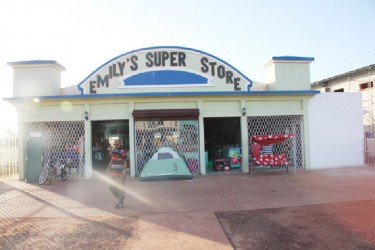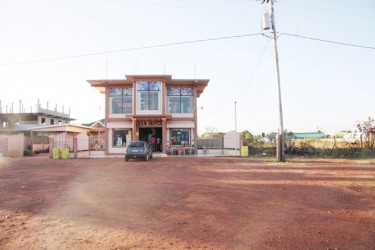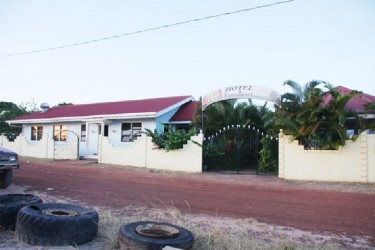Lethem is not what it used to be. The Rupununi’s largest township, with a population of approximately 7,000, lies on the Takutu River where it forms a border with Brazil. Opposite Lethem is the Brazilian township of Bonfim.
Lethem and more particularly the Takutu Bridge, continue to symbolise Guyana’s vision of an economy energized by significantly enhanced trading relations with Brazil. Market access to northern Brazil, particularly, could potentially be worth billions of dollars.

The goods apart, the road from Georgetown to Lethem remains a work in progress. Small local companies have used the opening of the Takutu Bridge to secure relatively lucrative niches on the Brazil side of the border. As long as the road remains unfinished and Brazil continues to be without a quicker sea route to the Caribbean and the wider world, the promise of wider economic relations Brazil will remain attainable but inaccessible.
Still, Lethem remains a symbol, a reference point for political pronouncements that hold forth a promise of closer ties with Brazil which, up until now, exists mostly in the realm of potential. For the moment, what Lethem has is its reputation as the main commercial centre of the Rupununi savannahs. That reputation had been built on vaqueros or cowboys and ranches, its other key economic activities being mineral extraction and tourism. The local population comprises mainly Macushi and Wapishana and, these days, increasingly, coastal Guyanese and Brazilians.
Long before the bridge across the Takutu River was opened in 2009 it had been predicted that the creation of a permanent link would accelerate ties between Lethem and Northern Brazil. Those ties are now limited but commonplace. They are most evident in the highly visible social and economic links that have been developed.
The Brazilians who cross the Takutu River to enter the Rupununi are mostly interested in what Guyana’s goldfields have to offer. But that is not their sole interest. These days they cross the bridge as a matter of course. Sometimes, often, there are more vehicles with Brazilian registration numbers on the Lethem side of the bridge than there are Guyanese vehicles.
For coastal Guyanese Lethem has been rendered more accessible these days by the still far from perfect road. In bad weather the ten to 12-hour journey by bus – with two stops along the way – is just the sort of contemporary adventure that many travellers embrace.
Those with less taste for that kind of adventure exercise the option of getting to Lethem by air. Both Air Services Ltd and Trans Guyana Ltd provide flights twice weekly, between Monday and Saturday. Getting to Lethem by air costs around $25,000; by road you pay about half of that. By air, you get there in about 90 minutes.

The other thing that the advent of the Takutu Bridge has done is to give rise to increased trade between the neighbouring communities. After the Takutu Bridge had been commissioned by the then Presidents of Guyana and Brazil, Lula Da Silva and Bharrat Jagdeo the two countries signed a Partial Scope Agreement that allows for the tariff-free movement of goods. The trade is still a trickle but at least it’s a start. For decades there had been virtually no formal relationship to speak of between Guyana and Brazil.
Lethem’s main shopping area is Barrack Retreat. It is populated by several well-established business houses run by Guyanese, Brazilians and, unsurprisingly, Chinese. The structures that accommodate the commercial houses are huge, even sprawling. There are hardware shops, clothing stores and supermarkets. It is not difficult to determine that the vast majority of the stores’ customers are Brazilians. They come over from Bonfim in their vehicles to buy fuel, clothing, food and household appliances. Guyanese go the other way seeking, among other things, medical services.
Mr Deen is Guyanese and runs one of the larger general stores on Barrack Retreat. He was, he says, one of the first businessmen to open his business on Barrack Retreat. Brazilians account for 98% of his sales. They come mostly at the month ends and approaching holidays. Those days compensate for the periods where for days on end not as soul comes to his shop. Prices are displayed in both Brazilian reals and Guyana dollars. One real is equivalent to ninety Guyana dollars.
The clothing resembles items that you can purchase in Georgetown and the prices are comparable. In much the same way that you might get an eye-catching jersey for around $800, or a pair of shoes for $6,000, so too you can get those items at the same prices at Lethem. While Stabroek Business was there, stores were offering washing machines at just over $50,000 and bicycles, the primary means of transport for school children at around $14,000.
Deen says things are beginning to change. Of late, it seems that Brazilians are cashing in on the cheap goods currently being offered in Venezuela.
Deen also talks of a more favourable exchange rate for the Brazilian real in Venezuela.

One of the other Guyanese businesses operating at Lethem is The Takutu Suites, a 32-room hotel that has been run by the Johnson family since 1969. Transportation is part of the Takutu service; a trip between Lethem and Annai cost around $60,000.
Ivan Johnson, the second generation proprietor told us that the December rodeo brings the most patronage. He too is plagued by Lethem’s power outages and is currently contemplating the
purchase of a second generator. That means that the Takutu’s running costs will probably increase. Rates for hotels at Lethem start at around $5,500 and can extend to $20,000. Johnson is aware of impending competition in the form of another hotel currently under construction and scheduled for completion very shortly.
Unreliable electricity is the bane of the Lethem business community’s existence. The state-run Lethem Power Company has become highly unreliable, the expansion of the business community having long outgrown the capacity of the facility.
Electricity apart, the hotels complain that reliable help is hard to find. High staff turnover impacts negatively on the kinds of routines that hotels need. Hotel staff, mostly Amerindians, come and go with monotonous regularity. The practice amongst them is to ‘catch their hands’; and move on. It’s bad for the hospitality business. An exodus of staff means that more training and more recruitment has to be done.
It is the Takutu Bridge that remains at the centre of the social and economic relationships between Lethem and Bonfim. It persists in an atmosphere of unfussiness, the reality of two countries separated by hugely differing levels of development. There may have been hopes expressed for what the diplomats call “closer bilateral ties” but in many respects that closeness is still far away.
The Guyanese and Chinese businesses purchase their goods from Georgetown. Deen says that it cost as much as $400,000 to move a truck of goods from Georgetown to Lethem. There are quite a few Brazilian businesses at Lethem. Their goods come across the Takutu Bridge, into Guyana.
There are two other popular hotels at Lethem, the Ori, which opened for business five years ago, and the Savannah Inn. The seasonal nature of business can be tracked through visitor arrivals at the hotels. There are Brazilians and conventional tourists and sometimes, intrepid travellers looking for something out of the ordinary. Government officials who travel to Lethem on various assignments also contribute to the local economy.
Lethem is deserving of a far better main thoroughfare than the existing Barrack Retreat. It is meant to be an all-weather asphalt road but periodic repairs never seem to last for more than six months. The road is currently in a deplorable state. The lesser roads are also an eyesore. Comments on the state of the roads at Lethem and why they are in such a deplorable condition are far from flattering.
It is Lethem, nonetheless, that remains the key growth point in the Repununi. There is a construction boom in the township and some of the emerging structures are far from modest. Lethem may have its ups and downs but the transformation cannot hide.





